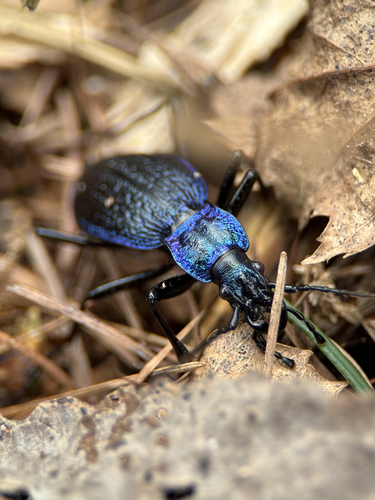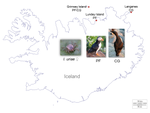
SPERLING Felix
- Biological Sciences, University of Alberta, Edmonton, Canada
- Genetics/Genomics, Insecta, Systematics
- recommender
Recommendations: 2
Reviews: 0
Recommendations: 2

Museomics of Carabus giant ground beetles shows an Oligocene origin and in situ Alpine diversification
Natural history collections continue to inform ground beetle genetics.
Recommended by Felix Sperling based on reviews by Michael Caterino, Julian Dupuis and 1 anonymous reviewerSome of the biodiversity of our planet now exists only in museums, due to continuing habitat destruction and climate change. With more than 380 million entomological specimens already preserved in museums (Johnson and Owens 2023), there is much work left to document what we already have. Fortunately, new advances in DNA sequencing have given us the opportunity to get enormous amounts of information from dried specimens on pins.
One such advance is HyRAD-X, which uses RAD-derived probes originally developed using RNA extracted from a selection of specimens with high RNA-integrity (Schmid et al. 2017). These exome-limited probes can then be used to capture low-integrity DNA extracted from a single leg from museum specimens, followed by Illumina sequencing of the enriched libraries.
Ground beetles allow an excellent demonstration of this approach, as their diversity, large size, and charismatic appearance has led to them being well represented in museums. Using a HyRAD-X probe set previously developed for a higher phylogeny within the subfamily Carabinae (Toussaint et al. 2021), the authors have now applied the same probe set to produce a comprehensive phylogeny for Arcifera, a clade of four subgenera and ten species within the genus Carabus (Pauli et al. 2024).
Of the 96 specimens that they started out with, 90% were from natural history collections and 40% dropped out immediately due to poor DNA extraction yield. After filtering the resulting sequence reads for minimum coverage and minimum number of samples per locus, they ended up with 35 museum specimens with an average of 793 loci. Phylogenetic analysis of this data supported the current classification of these beetles.
Pauli et al’s. (2024) study has effectively shown the power of HyRAD-X methods for applications at the species level. In-house production of probes makes the method accessible, expanding the opportunity to use museum specimens for population genetic research.
References
Johnson KR, Owens, (IFP. 2023) A global approach for natural history museum collections. Science 379,1192-1194(2023). https://doi.org/10.1126/science.adf6434
Pauli MT, Gauthier J, Labédan M, Blanc M, Bilat J, Toussaint EFA (2024) Museomics of Carabus giant ground beetles shows an Oligocene origin and in situ alpine diversification. bioRxiv, ver. 5 peer-reviewed and recommended by Peer Community in Zoology. https://doi.org/10.1101/2024.03.21.586057
Schmid, S., Genevest, R., Gobet, E., Suchan, T., Sperisen, C., Tinner, W. and Alvarez, N. (2017), HyRAD-X, a versatile method combining exome capture and RAD sequencing to extract genomic information from ancient DNA. Methods Ecol Evol, 8: 1374-1388. https://doi.org/10.1111/2041-210X.12785
Toussaint EFA, Gauthier J, Bilat J, Gillett CPDT, Gough HM, Lundkvist H, Blanc M, Muñoz-Ramírez CP, Alvarez N (2021) HyRAD-X Exome Capture Museomics Unravels Giant Ground Beetle Evolution, Genome Biology and Evolution, Volume 13, Issue 7, evab112, https://doi.org/10.1093/gbe/evab112

Within and among population differences in cuticular hydrocarbons in the seabird tick Ixodes uriae
Seabird tick diversification and cuticular hydrocarbons
Recommended by Felix Sperling based on reviews by 2 anonymous reviewersTicks are notorious vectors of diseases in humans and other vertebrates. Much effort has been expended to understand tick diversity and ecology with the aim of managing their populations to alleviate the misery they bring. Further, the fundamental question of whether ticks are usually host generalists or host specialists has been debated at length and is important both for understanding the mechanisms of their diversification as well as for focusing control of ticks [1].
One elegant resolution of this question is to consider most tick species to be global generalists but local specialists [1]. This is well illustrated in a series of studies of the seabird tick, Ixodes uriae, which is comprised of host-specific races that show genetic [2], morphological [3] and host performance [4] differences associated with the seabirds they feed on. Such a pattern has clear ramifications for sympatric speciation; however, the factors that potentially act to drive these differences have remained elusive.
Dupraz et al. [5] have now made intriguing and important steps toward bridging the gap between demonstrating local patterns of tick host association and understanding the physiological mechanisms that may facilitate such divergences. They collected I. uriae ticks from the nests of two seabirds – Atlantic puffins and common guillemots – on the north side of Iceland. Four populations of ticks were sampled, with one island providing both puffin ticks and guillemot ticks, to give two tick populations from each of the two seabird host species. They then washed the ticks in solvent and analyzed the dissolved cuticular hydrocarbons (CHCs) using GC mass spectrometry, revealing 22 different hydrocarbon compounds common to most of these samples. CHCs are known to be important across arthropods for a variety of functions ranging from reducing water loss to facilitating communication and recognition between individuals with species.
Dupraz et al. [5] found three hydrocarbons that distinguished puffin ticks most consistently from guillemot ticks. A cross-validation test for host type also assigned 75% of the tick pools to the seabird host of origin. However, with these limited sample sizes, statistical analysis revealed no significant difference in CHC profiles between the host types, although a tendency was evident. Nonetheless, this study revealed a number of potentially diagnostic CHCs for tick host type, as well as some that may be more diagnostic of locations. This provides a fascinating and actionable foundation for further work using additional sites and host types, as well as an entry point into discerning the mechanisms at play in producing the diversity, complexity and adaptability that make ticks such medical menaces.
References
[1] McCoy, K.D., Léger, E., Dietrich, M., 2013. Host specialization in ticks and transmission of tick-borne diseases: a review. Front. Cell. Infect. Microbiol. 3. https://doi.org/10.3389/fcimb.2013.00057
[2] McCoy, K.D., Chapuis, E., Tirard, C., Boulinier, T., Michalakis, Y., Bohec, C.L., Maho, Y.L., Gauthier-Clerc, M., 2005. Recurrent evolution of host-specialized races in a globally distributed parasite. Proc. R. Soc. B Biol. Sci. 272, 2389–2395. https://doi.org/10.1098/rspb.2005.3230
[3] Dietrich, M., Beati, L., Elguero, E., Boulinier, T., McCoy, K.D., 2013. Body size and shape evolution in host races of the tick Ixodes uriae. Biol. J. Linn. Soc. 108, 323–334. https://doi.org/10.1111/j.1095-8312.2012.02021.x
[4] Dietrich, M., Lobato, E., Boulinier, T., McCoy, K.D., 2014. An experimental test of host specialization in a ubiquitous polar ectoparasite: a role for adaptation? J. Anim. Ecol. 83, 576–587. https://doi.org/10.1111/1365-2656.12170
[5] Dupraz, M., Leroy, C., Thórarinsson, T. L., d’Ettorre, P. and McCoy, K. D. (2022) Within and among population differences in cuticular hydrocarbons in the seabird tick Ixodes uriae. bioRxiv, 2022.01.21.477272, ver. 5 peer-reviewed and recommended by Peer Community in Zoology. https://doi.org/10.1101/2022.01.21.477272